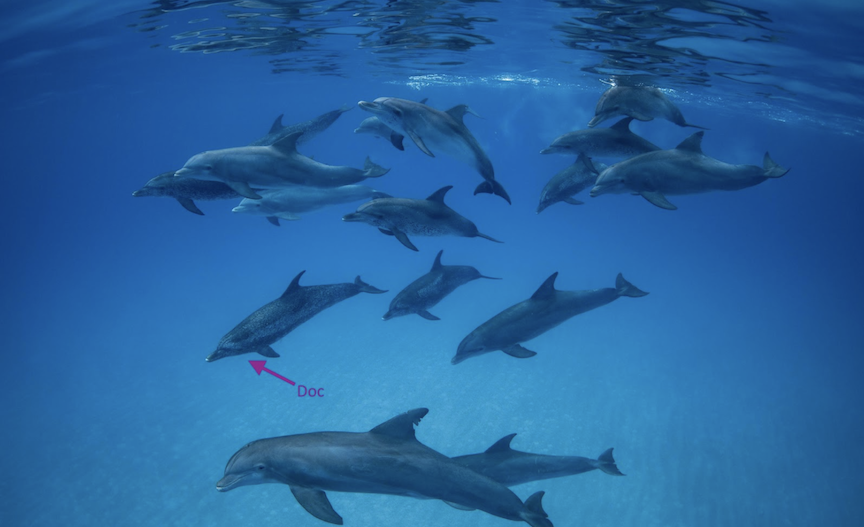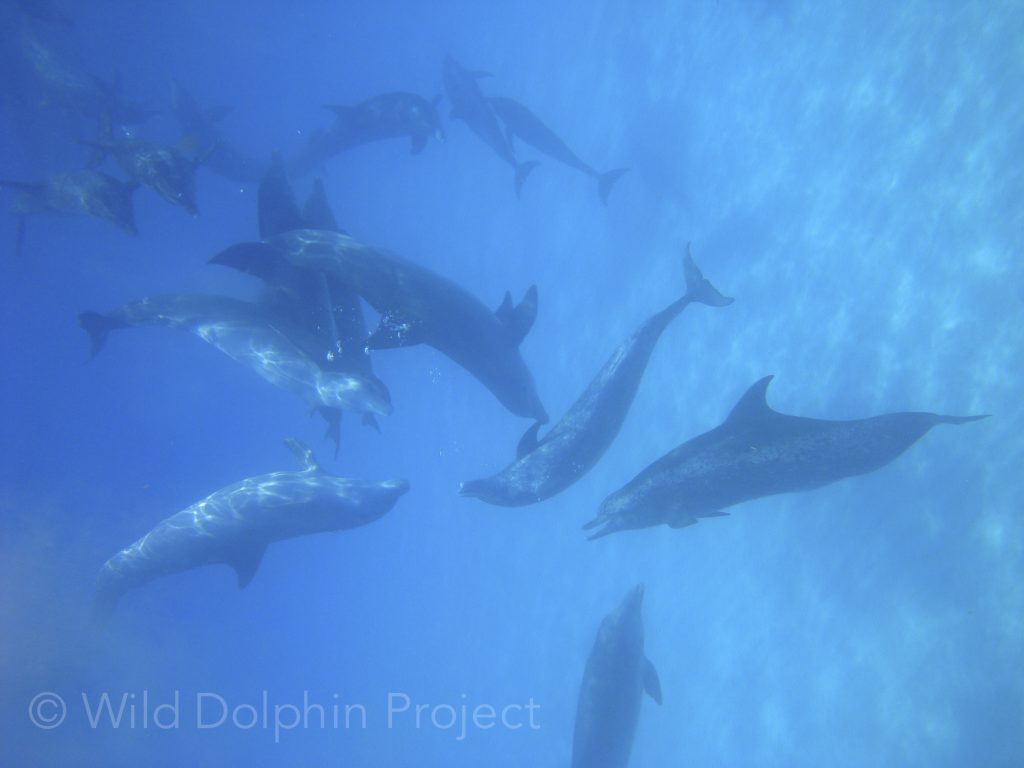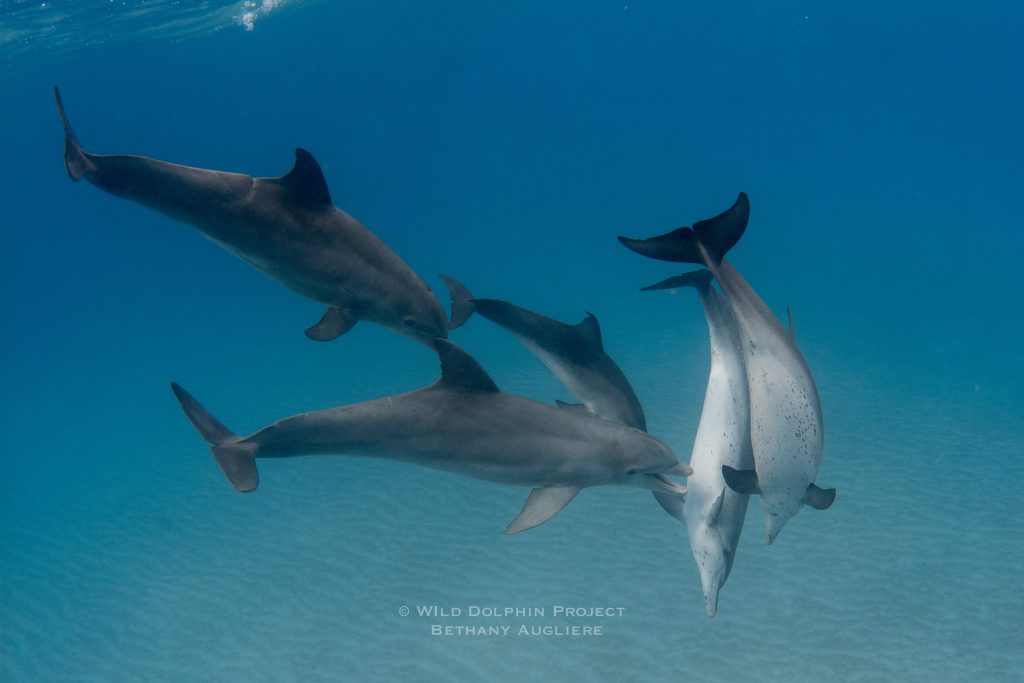In the Bahamas, the Wild Dolphin Project led by Dr. Denise Herzing, studies both the common bottlenose dolphin (Tursiops truncatus) and the Atlantic spotted dolphin (Stenella frontalis), who coexist on the sandbank. This means they are sympatric — occurring within the same geographic range.
While the two species eat slightly different fish and use different habitats within the bank, they do overlap, occasionally interact and even form mixed species groups. We study those interactions, which are called inter-specific interactions. Inter means between, as in, between species. Amongst dolphins, mixed-species groups are widespread, but little is known about their function (Syme et al., 2003).
Also to note, intra-specific interactions are those that occur between individuals of the same species, which we also study.

A mixed species group in the Bahamas. Photo copyright Wild Dolphin Project.
Mixed Groups
In the Bahamas, the nature of the inter-specific interactions varies. Based on a 1997 Wild Dolphin Project study by Herzing and Johnson, of 1246 encounters with dolphins, more than 15% were mixed species activity. Of these encounters, 60% were non-aggressive/affilitativc, 34.9% were aggressive, and 4.8% involved feeding activity. Compared to single species, mixed species encounters were (1) longer in duration and (2) larger in group size. In one instance, a young adult female spotted dolphin was with an emaciated bottlenose dolphin calf.
In mixed-groups, there are several benefits that could explain these interactions, such as protection from predators or care of young, due to similar behavior and anatomy between the two species. For example, Kiszka et al. (2011) suggested that spinner dolphins (Stenella longirostris) form mixed-species groups with pantropical spotted dolphins (Stenella attenuata) around the western Indian Ocean island of Mayotte to reduce predation risk when traveling in deep water with an increased predation risk.
But, what’s particularly interesting to WDP researchers is WHY these two species fight. Most of the fighting observed occurs between males of both species. During these same-sex aggressive encounters between the male bottlenose and male spotteds, we see behaviors such as biting, tail-slapping, and the bottlenose side-mount and mate with the male spotteds, but the reverse is never true (Herzing and Elliser, 2013). In fact, if you didn’t know the sex of the individuals in the group, you might assume it was interspecies mating – but it’s not!

Aggressive encounter between spotted and bottlenose dolphins.
Why Fight?

Bottlenose and spotteds during an aggressive inter-species encounter.
During the day, spotted dolphins and bottlenose dolphins do not seem to be competing for food resources. Malinowski (2011) found that bottlenose dolphins foraged more often in deeper waters than the spotted dolphins and their primary prey items differed during the day. Spotted dolphins also do not seem to be defending a specific territory. Cusick and Herzing (2014) did not find a significant clustering of interspecific aggressive encounters within our study site, suggesting that there is no physical boundary that separates bottlenose and spotted dolphin territories.
One possibility for the differences in aggressive style could result from spotted dolphins competing against the larger bottlenose dolphins for mating opportunities with females. Male bottlenose dolphins are roughly one meter larger than male spotted dolphins. Herzing and Elliser (2013) have
observed copulations between both species and have observed some suspected hybrids over the years
(Herzing et al., 2003) but genetic confirmation is still underway.
Our research assistant Cassie Volker did a paper, with Dr. Denise Herzing, comparing how the spotteds use different behaviors when fighting each other, versus when the fight the bottlenose. She showed that spotted dolphins use more energy intensive and risky behaviors when fighting interspecifically — meaning when they fight the bottlenose. This could result from having to fight and defend females from a larger species, trying to avoid sexual harassment from bottlenose males, or needing to use behaviors that are more overt and easily understood during interspecies communication, she said.
While mixed groups between dolphins species are common, they are often brief and poorly understood. To our knowledge, this type of interaction between these two species has only been observed in the Bahamas — until recently (stay tuned for updates on that). The more documentation and records we have of these inter-specific interactions and mixed groups, the more we can begin to understand their function.
REFERENCES:
Syme, J., Kiszka, J.J. & Parra, G.J. Multiple social benefits drive the formation of mixed-species groups of Australian humpback and Indo-Pacific bottlenose dolphins. Behav Ecol Sociobiol 77, 43 (2023). https://doi.org/10.1007/s00265-023-03320-y
Volker, C. L., & Herzing, D. L. (2021). Aggressive behaviors of adult male Atlantic spotted dolphins:
Making signals count during intraspecific and interspecific conflicts. Animal Behavior and Cognition, 8(1), 36–51.
https://doi.org/10.26451/abc.08.01.04.2021
use [unpublished master’s thesis]. Florida Atlantic University.
